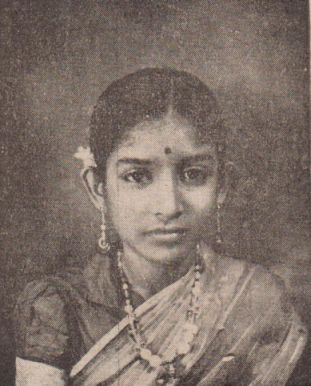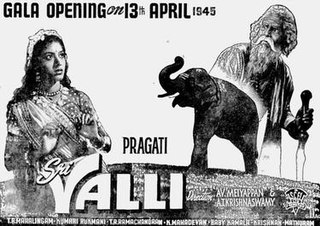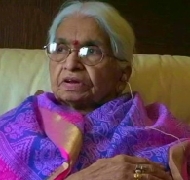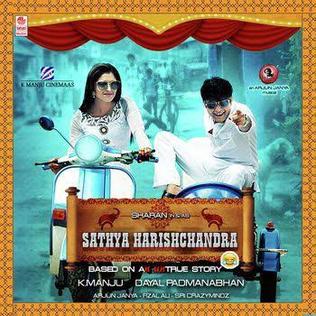
Harishchandra is a legendary king of the Solar dynasty, who appears in several legends in texts such as the Aitareya Brahmana, Mahabharata, the Markandeya Purana, and the Devi Bhagavata Purana. The most famous of these stories is the one mentioned in the Markandeya Purana. According to this legend, Harishchandra gave away his kingdom, sold his family, and agreed to be a slave – all to fulfill a promise he had made to the sage Vishvamitra.

AVM Productions is an Indian film production studio founded by A. V. Meiyappa Chettiar. It is the oldest studio in India. The filming studios are located in Vadapalani, Chennai. It has produced over 300 films in Tamil, Telugu, Kannada, Malayalam and Hindi cinema. AVM has introduced numerous actors in Southern industries, some of the prominent actors are Superstar Rajnikanth, Sivaji Ganesan, Rajkumar, S. S. Rajendran, Vyjayanthimala, Kamal Haasan and many more. The AVM Studios besides the shooting floors, has recording, dubbing and a preview theatre. The complex also houses facilities for production and post production processing.

Kadiri Venkata Reddy was an Indian film director, screenwriter, and producer who primarily worked in Telugu cinema. He is regarded as an influential director in South Indian cinema. He directed 14 feature films and won three National Film Awards and a Filmfare Award South.
Sati Sulochana is a 1934 Indian Kannada-language film directed by Y. V. Rao. The film was released on 3 March 1934 and is the first talkie film in Kannada language. It is also the first film to be screened in the erstwhile Mysore Kingdom.

Gurusala Krishnadas Venkatesh was an Indian film score composer who primarily worked in Kannada cinema during the 1960s, 1970s and until the late-1980s. He also composed music for Telugu, Malayalam and Tamil films. He produced numerous master pieces of Kannada film music and also brought in Western background score into Kannada films and scored music for all Bond movies of Rajkumar in the 1960s to 1970s.

Satya Harischandra is a 1965 Indian Kannada epic film directed by Hunsur Krishnamurthy and produced by K. V. Reddy. It stars Dr. Rajkumar in the lead role, as Harishchandra, an Indian mythological king, who was renowned for upholding truth and justice under any circumstance. The film is based on poet Raghavanka's work, Harishchandra Kavya. The supporting cast features Udaykumar, Pandari Bai, Narasimharaju, M. P. Shankar, K. S. Ashwath and Baby Padmini. This was the second Kannada movie based on king Harishchandra, the first one being the 1943 movie Satya Harishchandra.

Satya Harishchandra is a 1965 Indian Telugu-language Hindu mythological film, based on the life of Harishchandra, produced and directed by K. V. Reddy under the Vijaya Productions banner. It stars N. T. Rama Rao and S. Varalakshmi, with music composed by Pendyala Nageswara Rao.

Pillavalu Gajapathy Krishnaveni, more famously known as Jikki, was an Indian playback singer from Andhra Pradesh. She sang around 10,000 songs in Telugu, Tamil, Kannada, Malayalam, Sinhalese, and Hindi languages.
Rushyendramani was an Indian actress, singer, dancer, and playback singer from Andhra Pradesh. She had more than 150 movies to her credit and acted in Telugu, Tamil, Kannada, Malayalam and Hindi films from 1935 to 1986. Her notable films include Sri Seetarama Jananam (1944), Malliswari (1951), Vipra Narayana (1954), Chintamani (1956). Her last film was Sri Shirdi Saibaba Mahathyam (1986).
Harishchandra is an Indian king mentioned in ancient Hindu religious texts.

Bhookailas is a 1940 Telugu film produced by A. V. Meiyappan and directed by Sundar Rao Nadkarni. The film starred Subbaiah Naidu, R. Nagendra Rao, and Rayaprolu Subramanyam. It was the first hit film after the establishment of AVM Productions.

Vasantasena is a 1941 Indian Kannada-language film directed by Ramayyar Shirur. It stars Lakshmi Bai, Subbayya Naidu and Nagendra Rao in lead roles. The film is based on the Sanskrit play, Mṛcchakatika by Śūdraka.

Rattihalli Nagendra Rao was an Indian theatre actor, film actor and director in South Indian cinema. Following his career in theatre, Rao turned to film a where he became an actor, director, producer, screenwriter and occasional composer. He is considered one of the most influential personalities in the history of South Indian cinema.

Mysore Venkatappa Subbaiah Naidu was an Indian theatre and film actor. He was well known for his work in films like Sati Sulochana (1934)—the first Kannada talkie film, Bhookailas (1940) in Telugu, and Bhakta Prahlada (1958) in Kannada. He acted in the first Kannada talkie film and brought distinction to Kannada cinema. He was the father of Kannada actor Lokesh and the grandfather of Kannada TV personality Srujan Lokesh. Recognizing his work in theatre, he was awarded the Sangeet Natak Akademi Award in 1961.
Bettada Kalla is a 1957 Indian Kannada film, produced and directed by S. M. S. Naidu. The film stars Kalyan Kumar, Mynavathi, R. Nagendra Rao and Udaykumar in the lead roles. The film has musical score by S. M. Subbaiah Naidu. The movie was a remake of the director's own 1954 Tamil movie Malaikkallan, thereby becoming the first remake in the Kannada film industry.

Sri Valli is a 1945 Tamil-language film co-directed by A. V. Meiyappan and produced by him under Pragathi Studios. It was co-directed by A. T. Krishnaswamy who also wrote the script. The film stars T. R. Mahalingam and Kumari Rukmani. Sri Valli revolves around the romance between Muruga and Valli, a tribal girl. The rest of the story shows how Valli wins the heart of Murugan.

K. Rani was an Indian playback singer who has sung songs in Telugu, Tamil, Kannada, Malayalam, Sinhalese, Hindi, Bengali and Uzbek. Rani was the first female singer from India to sing in Sinhalese and Uzbek, and sang the national anthem of Sri Lanka.

Mahatma Kabir is a 1947 Indian Kannada-language film directed by R. Nagendra Rao. He also stars in the lead role alongside Subbaiah Naidu. The film deals with Mahatma Gandhi's vision of harmony between the Hindus and Muslims. It was set in the backdrop of the religious violence in India that took place after the Independence from the British rule.

Satya Harishchandra is a 2017 Indian Kannada language romantic comedy film written and directed by Dayal Padmanabhan. It is produced by K. Manju under his K. Manju Cinemaas banner. It features Sharan, Sanchita Padukone and Bhavana Rao. The score and soundtrack for the film is by Arjun Janya and the cinematography is by Faisal Ali. The film was launched officially on 18 September 2016 and the filming took place at Mysore, Melukote and Portugal. The film released on 20 October 2017 during the Diwali festival.















